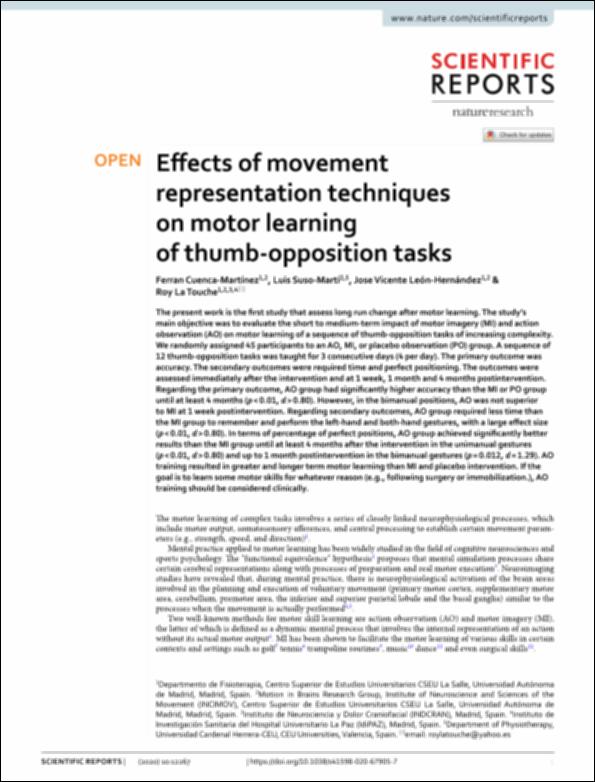Please use this identifier to cite or link to this item:
http://hdl.handle.net/10637/12736Effects of movement representation techniques on motor learning of thumb-opposition tasks
| Title: | Effects of movement representation techniques on motor learning of thumb-opposition tasks |
| Authors : | Cuenca Martínez, Ferran Suso Martí, Luis León Hernández, José Vicente La Touche Arbizu, Roy |
| Keywords: | Neurofisiología.; Sistema musculoesquelético - Fisiología.; Aprendizaje motor.; Motor learning.; Fingers - Mechanical properties.; Neurophysiology.; Psicomotricidad.; Movement, Psychology of.; Dedos de la mano - Propiedades mecánicas.; Musculoskeletal system - Physiology. |
| Publisher: | Nature Research. |
| Citation: | Cuenca-Martínez, F., Suso-Martí, L., León-Hernández, J.V. & La Touche, R. (2020). Effects of movement representation techniques on motor learning of thumb-opposition tasks. Scientific Reports, vol. 10, art. 12267 (23 jul.). DOI: https://doi.org/10.1038/s41598-020-67905-7 |
| Abstract: | The present work is the first study that assess long run change after motor learning. The study’s main objective was to evaluate the short to medium-term impact of motor imagery (MI) and action observation (AO) on motor learning of a sequence of thumb-opposition tasks of increasing complexity. We randomly assigned 45 participants to an AO, MI, or placebo observation (PO) group. A sequence of 12 thumb-opposition tasks was taught for 3 consecutive days (4 per day). The primary outcome was accuracy. The secondary outcomes were required time and perfect positioning. The outcomes were assessed immediately after the intervention and at 1 week, 1 month and 4 months postintervention. Regarding the primary outcome, AO group had significantly higher accuracy than the MI or PO group until at least 4 months (p < 0.01, d > 0.80). However, in the bimanual positions, AO was not superior to MI at 1 week postintervention. Regarding secondary outcomes, AO group required less time than the MI group to remember and perform the left-hand and both-hand gestures, with a large effect size (p < 0.01, d > 0.80). In terms of percentage of perfect positions, AO group achieved significantly better results than the MI group until at least 4 months after the intervention in the unimanual gestures (p < 0.01, d > 0.80) and up to 1 month postintervention in the bimanual gestures (p = 0.012, d = 1.29). AO training resulted in greater and longer term motor learning than MI and placebo intervention. If the goal is to learn some motor skills for whatever reason (e.g., following surgery or immobilization.), AO training should be considered clinically. |
| Description: | Este artículo se encuentra disponible en la siguiente URL: https://www.nature.com/articles/s41598-020-67905-7.pdf |
| URI: | http://hdl.handle.net/10637/12736 |
| Rights : | http://creativecommons.org/licenses/by/4.0/deed.es |
| ISSN: | 2045-2322 (Electrónico). |
| Issue Date: | 23-Jul-2020 |
| Center : | Universidad Cardenal Herrera-CEU |
| Appears in Collections: | Dpto. Enfermería y Fisioterapia |
Items in DSpace are protected by copyright, with all rights reserved, unless otherwise indicated.


